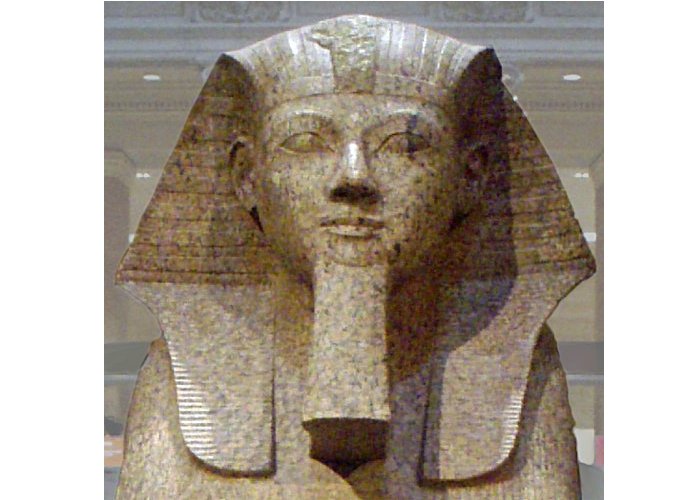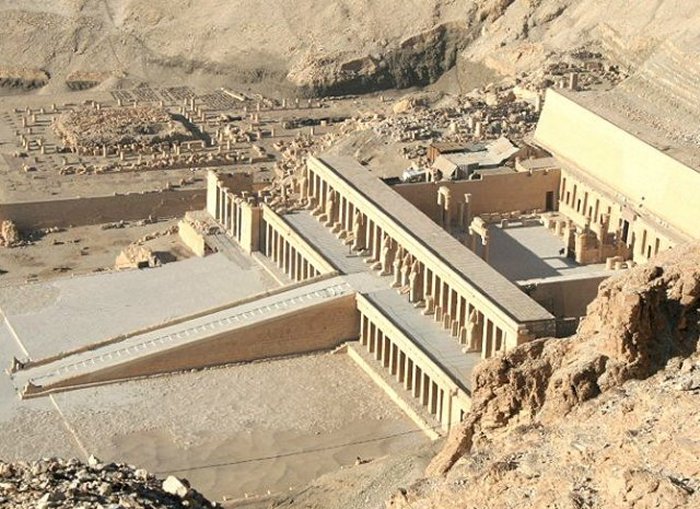Pharaoh Hatshepsut: Skillful And Efficient Female Ruler Who Brought Prosperity To Ancient Egypt
A. Sutherland - AncientPages.com - Hatshepsut, whose name means "Foremost of Noble Ladies," is a notable name in history.
She lived almost three and a half thousand years ago and ascended the throne of Egypt between 1512 BC and 1479 BC.
Credit: Public Domain
Her skills, efficiency, and personality made her one of the most intriguing and successful pharaohs that reigned in Egypt.
Hatshepsut Was A Clever Ruler
She was the queen of Pharaoh, King Thutmose II, and after he died, she quickly installed his son on the throne as Thutmose III (1458-1425 BC). She took the title of ‘regent’ because the boy was much too young to make any decisions. As she was not his mother, she could not rule in his name.
Based on the inscription of the vizier Ineni, architect, and government official of the 18th Dynasty, who during the reign of Hatshepsut, supervised several structures commissioned by her, she exercised her authority openly from the beginning and cited only her title God's Wife, which referred to her important function in the temple of Amun-Re and may have assured her the political support of that god's priests.
At some point, she decided to rule the country. She was crowned king, claimed a divine right to rule based on the authority of the god Amun and began to dress as a male pharaoh, and even wore the pharaoh's “beard’ that was part of their sign of power. She was the fifth pharaoh of the Eighteenth dynasty.
Credit: Public Domain
It is known that she was one of the best pharaohs that ever lived in Egypt. She ruled efficiently, wisely and brought success and prosperity to her land. As a pharaoh, she sent out several military expeditions mainly to the regions of Nubia and Syria and most probably to uphold the tradition of the pharaoh as a warrior-king bringing prosperity into the land through conquests.
Unlike the other pharaohs, she focused more on expanding the economy and negotiating peaceful relations with neighbors.
Expeditions And Building Projects
During her ninth year of reigning, she established the trade networks, which were only disrupted during the Hyksos invasion and occupation of Egypt during the Second Intermediate Period (c. 1782 - c.1570 BC).
She sent trading expeditions to the land of Punt, and returning ships were loaded with the finest goods such as myrrh, trees, ivory, and gold. Hatshepsut had several building projects, built new monuments, and restored some of the older structures throughout Egypt.
Perhaps one of her best building projects was the Mortuary Temple of Hatshepsut (also known as the Djoser-Djeseru (“holiest of holy places”), a masterpiece with terraced architecture and sculptures. It was dedicated to the god Amon and located at Deir el-Bahri ("the Northern Monastery"), near the Valley of the Kings, in western Thebes.
Hatshepsut ordered both constructions and restorations. The original Precinct of Mut dedicated to the ancient great goddess of Egypt was restored after it was badly damaged during the Hyksos occupation.
Thutmose III Made Attempts To Erase Her From Memory Of People
After more than two decades as principal ruler of Egypt, the reign of Hatshepsut ended with her death in 1458 BC. Both her death and the events that followed her passing are still shrouded in mystery. When scientists examined her flacon, they discovered an ancient secret shedding more light on her death.
Sometime after her death, her co-ruler, Thutmose III, ordered her name and images destroyed. The process of eliminating Hatshepsut's memory did not begin immediately after her reign was over, but it was a deliberate, carefully planned act.
It was made according to orders of her nephew, Thutmose III. He desired to erase her legacy and everything that was related to her, including inscriptions. No mortuary priests were appointed to perpetuate her cult, and her name was omitted in the king lists of Abydos.
Did he hate her so much? Was it perhaps revenge?
Memory Of Her Lost And Restored
Until the mid-nineteenth century, all memory of Hatshepsut's seemed to have been lost, but fortunately - not entirely. Archaeologists found some references to her and could begin the reconstruction of her place in history.
In 1902, archaeologists discovered her empty tomb. Many years later, two female mummies were discovered, but one of them has long remained unidentified.
In 2007, the DNA from the tooth of the unidentified mummy helped to confirm the identity of Hatshepsut.
Written by – A. Sutherland AncientPages.com Staff Writer
Updated on August 4, 2021
Copyright © AncientPages.com All rights reserved. This material may not be published, broadcast, rewritten or redistributed in whole or part without the express written permission of AncientPages.com
Expand for referencesReferences:
Dell, Hatshepsut: Egypt's First Female Pharaoh
Weaver, Ancient Egypt
More From Ancient Pages
-
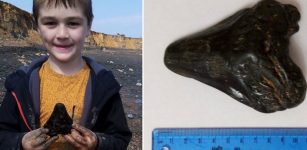 Schoolboy Finds A Huge 3,000,000-Year-Old Megalodon Shark Tooth On British Beach
Archaeology | May 9, 2022
Schoolboy Finds A Huge 3,000,000-Year-Old Megalodon Shark Tooth On British Beach
Archaeology | May 9, 2022 -
 Lost Mayan City Hidden Deep In The Peten Jungle Discovered By Expedition Team
Archaeology | Mar 21, 2022
Lost Mayan City Hidden Deep In The Peten Jungle Discovered By Expedition Team
Archaeology | Mar 21, 2022 -
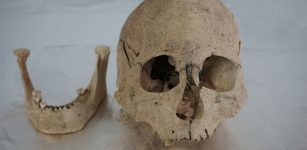 DNA Study Of Ancient Humans Sheds Light On Human Evolution On The Tibetan Plateau
Archaeology | Mar 21, 2023
DNA Study Of Ancient Humans Sheds Light On Human Evolution On The Tibetan Plateau
Archaeology | Mar 21, 2023 -
 Cinnabar And Hematite Were Used In Early Teotihuacan Murals – INAH Researchers Say
Archaeology | Aug 5, 2020
Cinnabar And Hematite Were Used In Early Teotihuacan Murals – INAH Researchers Say
Archaeology | Aug 5, 2020 -
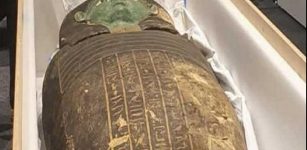 Egypt Recovers Ancient Wooden Coffin From Houston Museum In The US
Archaeology | Oct 4, 2022
Egypt Recovers Ancient Wooden Coffin From Houston Museum In The US
Archaeology | Oct 4, 2022 -
 Advanced Flying Machines And Interplanetary Travel Described 7000 Years Ago In India
Civilizations | Aug 20, 2015
Advanced Flying Machines And Interplanetary Travel Described 7000 Years Ago In India
Civilizations | Aug 20, 2015 -
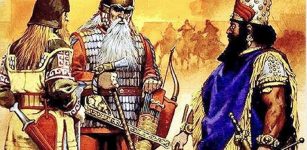 Nabopolassar: Father Of Nebuchadnezzar II And King Of Babylon Rose To Power Thanks To His Dedication To Gods Nabu And Marduk
Featured Stories | Jan 11, 2019
Nabopolassar: Father Of Nebuchadnezzar II And King Of Babylon Rose To Power Thanks To His Dedication To Gods Nabu And Marduk
Featured Stories | Jan 11, 2019 -
 Suprising Discovery Of A Well-Preserved Ancient Roman Road In London, UK
Archaeology | Nov 19, 2024
Suprising Discovery Of A Well-Preserved Ancient Roman Road In London, UK
Archaeology | Nov 19, 2024 -
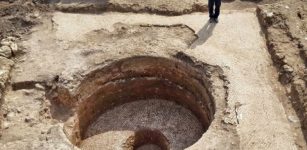 Large 1,500-Year-Old Winepress Unearthed In Area Once Known For Wine production.
Archaeology | Oct 29, 2015
Large 1,500-Year-Old Winepress Unearthed In Area Once Known For Wine production.
Archaeology | Oct 29, 2015 -
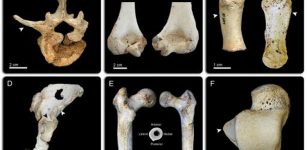 Human Body Has Gone Through Four Stages Of Evolution – New Study
Human Beginnings | Sep 1, 2015
Human Body Has Gone Through Four Stages Of Evolution – New Study
Human Beginnings | Sep 1, 2015 -
 A 5,000-Year-Old Anatolian Sword Identified In Armenian Monastery In Venice
Artifacts | Feb 28, 2020
A 5,000-Year-Old Anatolian Sword Identified In Armenian Monastery In Venice
Artifacts | Feb 28, 2020 -
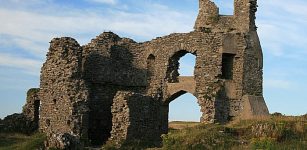 The Ruins Of Pennard Castle And The Tale Of Faeries’ Curse
Featured Stories | Mar 2, 2016
The Ruins Of Pennard Castle And The Tale Of Faeries’ Curse
Featured Stories | Mar 2, 2016 -
 Secret Ancient Knowledge Of Portals Leading To Unknown Realms -The Arrival And Departure – Part 1
Featured Stories | Dec 1, 2021
Secret Ancient Knowledge Of Portals Leading To Unknown Realms -The Arrival And Departure – Part 1
Featured Stories | Dec 1, 2021 -
 Has The Viking Ship Burial Of King Bjørn Farmann Been Found At Jarlsberg Manor, Norway?
Archaeology | Jul 2, 2024
Has The Viking Ship Burial Of King Bjørn Farmann Been Found At Jarlsberg Manor, Norway?
Archaeology | Jul 2, 2024 -
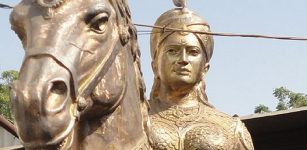 Rudrama Devi – Warrior Queen Of The Kakatiya Dynasty And First Female Ruler Of South India
Featured Stories | Jul 27, 2021
Rudrama Devi – Warrior Queen Of The Kakatiya Dynasty And First Female Ruler Of South India
Featured Stories | Jul 27, 2021 -
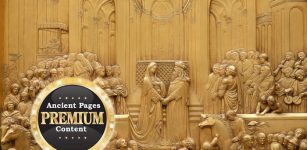 Secret Hidden Freemasonic Messages Concealed In Ancient Egyptian Artifacts And Roman Works – Curious Stellar Symbol – Part 2
Featured Stories | Feb 23, 2022
Secret Hidden Freemasonic Messages Concealed In Ancient Egyptian Artifacts And Roman Works – Curious Stellar Symbol – Part 2
Featured Stories | Feb 23, 2022 -
 Ancient Roman Port Discovered Off The Syrian Coast
News | Feb 16, 2021
Ancient Roman Port Discovered Off The Syrian Coast
News | Feb 16, 2021 -
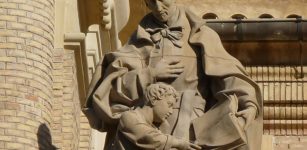 On This Day In History: First Public And Free School Opened For Poor Children – On Sep 15, 1616
News | Sep 15, 2016
On This Day In History: First Public And Free School Opened For Poor Children – On Sep 15, 1616
News | Sep 15, 2016 -
 Maya Site With At Least 300 Buildings Some Of Which Are Over 8 Meters High – Discovered
Archaeology | Sep 16, 2022
Maya Site With At Least 300 Buildings Some Of Which Are Over 8 Meters High – Discovered
Archaeology | Sep 16, 2022 -
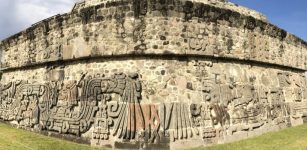 Xochicalco: Stunning Ruins Of Sacred City Linked To Maya and Aztecs Civilizations
Featured Stories | Feb 26, 2018
Xochicalco: Stunning Ruins Of Sacred City Linked To Maya and Aztecs Civilizations
Featured Stories | Feb 26, 2018


